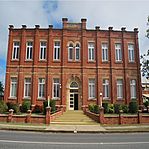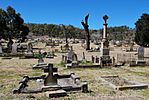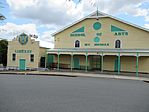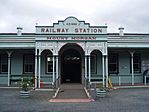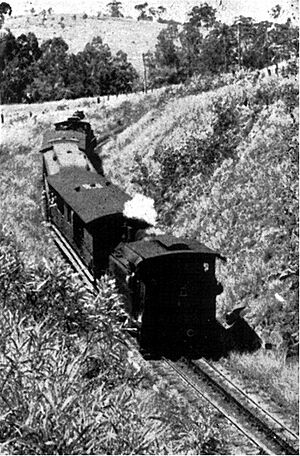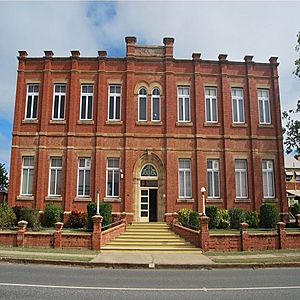Mount Morgan, Queensland facts for kids
Quick facts for kids Mount MorganQueensland |
|||||||||||||||
|---|---|---|---|---|---|---|---|---|---|---|---|---|---|---|---|
|
From left to right;
Old Technical College, Mount Morgan Cemetery Mount Morgan School of Arts, Mount Morgan railway station |
|||||||||||||||
| Population | 2,487 (2021 census (town)) | ||||||||||||||
| • Density | 205.5/km2 (532/sq mi) | ||||||||||||||
| Established | 1882 | ||||||||||||||
| Postcode(s) | 4714 | ||||||||||||||
| Elevation | 341 m (1,119 ft) | ||||||||||||||
| Area | 12.1 km2 (4.7 sq mi) | ||||||||||||||
| Time zone | AEST (UTC+10:00) | ||||||||||||||
| Location |
|
||||||||||||||
| LGA(s) | Rockhampton Region | ||||||||||||||
| State electorate(s) | Mirani | ||||||||||||||
| Federal Division(s) | Flynn | ||||||||||||||
|
|||||||||||||||
Mount Morgan is a town in Queensland, Australia. It is located in the Rockhampton Region. The town was once the main centre for the Shire of Mount Morgan. In March 2008, it joined with other local areas to form the Rockhampton Region.
In 2021, the town of Mount Morgan had about 2,487 people living there. The wider area, called the locality of Mount Morgan, had about 2,018 people.
Contents
Exploring Mount Morgan's Location
Mount Morgan is located on the Dee River. It is about 38 kilometres (24 miles) south of the city of Rockhampton. It is also about 680 kilometres (420 miles) north of Brisbane, the state capital. The Burnett Highway runs right through the town.
The area includes a few smaller neighbourhoods:
- Gordon Vale
- Kenbula
- Talban
The names Kenbula and Talban were given by the Queensland Railway Department in 1911. Both names come from Aboriginal languages. Kenbula means ironbark tree, and Talban means stone curlew.
A Look Back at Mount Morgan's Past
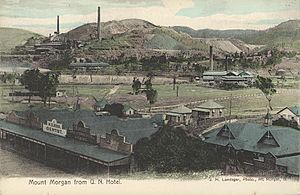
Before European settlers arrived, the land around Mount Morgan belonged to the Kangulu people.
How Mount Morgan Began
Mount Morgan started as a gold mining town in 1882. It was named after the Morgan family. Frederick Augustus Morgan and his brothers, Thomas and Edwin, were the first to get mining rights in the area.
The Mount Morgan Mine became very famous. Over the years, it produced huge amounts of gold, silver, and copper. One person who became very rich from this mine was William Knox D'Arcy. He used his money to look for oil in Iran. This led to the creation of a big oil company, which is now known as BP.
Discovering Dinosaur Footprints
Around the same time, people started digging for clay in a nearby hill. This clay was used to make bricks for furnaces. The digging created large caves, some as tall as 12 metres (39 feet). These caves became known as the Fireclay Caverns.
Later, something amazing was found in these caverns: Dinosaur footprints! These footprints were preserved on the cave ceilings. They are from the Early Jurassic period, which was millions of years ago.
Growing as a Town
The Mount Morgan Post Office opened in 1885. The town's first school, Mount Morgan Central State School, opened in 1887. It grew so fast that it split into two schools the next year. They joined back together in 1929.
By 1889, the town's name was officially changed to 'Mount Morgan'. Many churches were built, including Primitive Methodist (1885), Catholic (1887), and Anglican (1889) churches. By 1891, over 3,500 people lived in Mount Morgan.
The Arrival of the Railway
Before 1898, everything was moved by horse teams. The Mount Morgan Mining Company had a place where wagons would load up goods.
The railway line connecting Mount Morgan to Rockhampton opened on 26 November 1898. This made transport much easier. Two railway stations served the area:
- Mount Morgan railway station (now closed)
- Walterhall railway station (now closed)
The Mafeking Bell Story
Around 1900, the people of Mount Morgan were very excited about the Siege of Mafeking in South Africa. When news came that the siege was over, the town celebrated with bonfires and music.
A special "Mafeking" bell was made at the Mount Morgan Mine. It weighed about 360 kilograms (790 pounds)! The bell was first placed in a tower near the town hall. Later, it was moved to the scout hall because Lord Baden Powell, who started the Scouting movement, was a leader at Mafeking. In 2018, the bell was moved back to the main street of Mount Morgan.
There's a popular story that schoolchildren from Mount Isa donated pennies to help pay for the bell. However, this story seems to have started many years after the bell was made.
More Schools and the Mine's Closure
Sacred Heart Catholic Primary School opened in 1891 but closed in 1997. Red Hill State School opened in 1900 and closed around 1931.
Mount Morgan State High School opened on 22 January 1912. It was the first high school of its kind in Queensland.
The Mount Morgan Mine finally closed in November 1990. It had produced a huge amount of gold and copper. The mining left behind a large, deep pit filled with acid water. The Queensland Government is now working to clean up the mine site.
The Mount Morgan Public Library opened in 1993. In 2020, a 24-kilometre (15-mile) network of mountain bike trails was built around No. 7 Dam. This helps bring tourists to the town.
In 2021, the town faced a water shortage. Drinking water had to be delivered daily.
Mount Morgan's Heritage Sites
Mount Morgan has several places that are listed as heritage sites. This means they are important historical places. Some of these include:
- The Mount Morgan Mine
- Mount Morgan State High School
- The Grand Hotel
- Mount Morgan Cemetery
- Mount Morgan Masonic Temple
- St Mary's Anglican Church
- The Court House and Police Station
- The Coronation Lamp War Memorial
- The Queensland National Hotel
- Mount Morgan School of Arts
- The Commonwealth Bank Building
- Mount Morgan Central State School
- Mount Morgan railway station
- The Adolphus William Copper Smelter
What Mount Morgan Does Today
Mining companies are still looking for minerals in the area. There are also plans to get more gold from the leftover materials at the old mine site.
Learning in Mount Morgan
Mount Morgan Central State School is a government primary school for students from Prep to Year 6. It is located at 44 Morgan Street. In 2018, it had 209 students.
Mount Morgan State High School is a government secondary school for students from Year 7 to Year 12. It is located at 4 Central Street. In 2018, it had 183 students.
Places to Visit and Things to Do
The Rockhampton Regional Council runs the Mount Morgan Library. It is located at 31 Morgan Street.
The Mount Morgan branch of the Queensland Country Women's Association meets at the CWA Hall on East Street.
The Mount Morgan Mountain Bike Trails are managed by the Rockhampton Regional Council. You can enjoy social rides there, and there are plans for races to start in 2021.
There are several churches in Mount Morgan, including:
- St Mary's Anglican Church
- Sacred Heart Catholic Church
- Mount Morgan Uniting Church
- St Enoch's Presbyterian Church
- Peace Christian Church (which used to be the Mount Morgan Baptist Church)
Fun Events in Mount Morgan
Mount Morgan holds the Golden Mount Festival every year. It usually happens in late April or early May, around the Labour Day holiday. The festival lasts for a few days. On Saturday, Morgan Street is closed to cars for markets and fun activities. These include parades and "Running the Cutter" races.
Mount Morgan's Attractions
Tourism is important to Mount Morgan today. There is a visitor centre at the old railway station. This area was once home to a special type of rack railway. This railway helped trains climb steep hills. The railway line closed in 1987, so trains no longer come to Mount Morgan.
The Mount Morgan railway station building is still standing. It is now a Museum and Tourist Information Centre. You can also catch a bus service between Rockhampton, Gracemere, and Mount Morgan.
Famous People from Mount Morgan
- Jens Hansen Lundager: He was a mayor of Mount Morgan and a photographer.
- Alma Moodie: A concert violinist and teacher who lived in Germany.
- Stephen Moore (rugby union): The captain of the Wallabies (Australia's national rugby team). He lived in Mount Morgan when his family first moved to Queensland.
- Mervyn Henry Stevenson: A police superintendent and a member of the Australian Stockman's Hall of Fame.
Images for kids


